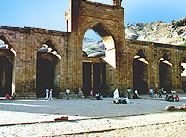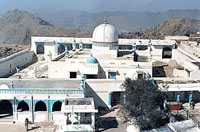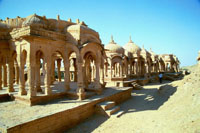Rajasthan Tourism
Rajasthan is a treasure house of tourist places. Jaipur, Jodhpur, Udaipur, Bikaner, Mount Abu, Sariska tiger sanctuary, Ajmer, Jaisalmer, Chittaurgarh and Bharatpur are the main attractions. Tourism in Rajasthan has grown so much that the remotest corners of Rajasthan seem to have become tourist hubs.
Jaipur, Rajasthan
The beautiful city of Jaipur is tucked away in the Aravalli hills. Founded in 1727 AD my Maharaja Jaisingh, Jaipur the capital of Rajasthan is widely known as the Pink City with broad roads and beautiful gardens.
more on Jaipur | Jaipur Pictures
Ajmer, Rajasthan
 The city of Ajmer is famous as a pilgrim place. It houses the Dargah or tomb of the popular 13th century, Sufi Saint Hazrat Khwaja Moinuddin Hasan Chisti. The city boasts of a number of monuments belonging to the Mughal Era. The city is also known for its traditional handicrafts. Adhai-din-ka-Jhompara mosque is on the outskirts of the city. Three kilometers beyond the mosque and located on a steep hill is the Taragarh Fort, which offers a breathtaking view of Ajmer city. The small town of Kishangarh is located 27 km from Ajmer and is famous for its traditional miniature paintings. Roopangarh Fort is 52 km from Ajmer and can be reached via Kishangarh.
The city of Ajmer is famous as a pilgrim place. It houses the Dargah or tomb of the popular 13th century, Sufi Saint Hazrat Khwaja Moinuddin Hasan Chisti. The city boasts of a number of monuments belonging to the Mughal Era. The city is also known for its traditional handicrafts. Adhai-din-ka-Jhompara mosque is on the outskirts of the city. Three kilometers beyond the mosque and located on a steep hill is the Taragarh Fort, which offers a breathtaking view of Ajmer city. The small town of Kishangarh is located 27 km from Ajmer and is famous for its traditional miniature paintings. Roopangarh Fort is 52 km from Ajmer and can be reached via Kishangarh.
Udaipur, Rajasthan
Udaipur has been the former royal house of Mewar. Lavished with palaces, lakes, cenotaphs and temples, it provides many interesting places to see, like the City Palace, Pichola Lake, Jag Niwas, Jagdish Temple, Eklingji Temple, Nathdwara, Rajsamand and Jaisamand. Chittaur, Kumbalgarh and Mandalgarh.
more on Udaipur
Shekhawati, Rajasthan
Shekhawati is like Rajasthan's very own Open Air Art Gallery. The districts of Churu, Jhunjhunu and Sikar form the mural-rich area of Shekhawati. The walls of the mansions owned by Marwari traders are adorned with some of the most exquisite frescoes, depicting a cavalcade of elephants, horses and camels.
Kota, Rajasthan
 Kota is located in the southern part of the state of Rajasthan. It is located on the eastern bank of Chambal River and is drained by its tributaries. Kota is on a high sloping tableland forming a part of the Malwa Plateau. Summers are quite hot (April-June) while winters are cool (October-February). It experiences scant rainfall between June and August. There are a number of interesting places to be visit in Kota. The city fort and palace, Kishore Sagar tank, The little Jagmandir palace, Brij Vilas Palace Museum, The Chambal gardens and the Chhattar Bilas gardens are the main ones to be visited.
Kota is located in the southern part of the state of Rajasthan. It is located on the eastern bank of Chambal River and is drained by its tributaries. Kota is on a high sloping tableland forming a part of the Malwa Plateau. Summers are quite hot (April-June) while winters are cool (October-February). It experiences scant rainfall between June and August. There are a number of interesting places to be visit in Kota. The city fort and palace, Kishore Sagar tank, The little Jagmandir palace, Brij Vilas Palace Museum, The Chambal gardens and the Chhattar Bilas gardens are the main ones to be visited.
Sariska National Park, Rajasthan
The Sariska National Park is 200 km from Delhi and 107 km from Jaipur. The landscape comprises of hills and narrow valleys of the Aravali hill range. Sariska National Park is home to numerous wild animals like Leopard, Wild Dog, Jungle Cat, Civets Hyena, Jackal, and Tiger. These feed on species such as Sambar, Chital, Nilgai, Chausingha, Wild Boar and Langur. Sariska is also well known for its large population of Rhesus Monkeys, which are found around Talvriksh. Birds like Peafowl, Grey Partridge, Bush Quail, Sand Grouse, Tree Pie, Golden backed Woodpecker, crested Serpent Eagle and The Great Indian horned Owl are a regular here. The park is open almost the whole year-round, but for wildlife viewing and your comfort it is best to visit from October to April. Jeep Safaris are generally available.
Mount Abu Sanctuary, Rajasthan
The sanctuary comprises the oldest mountain ranges - The Aravali.. Apart from having several sightseeing places this sanctuary is a draw for nature lovers as it has great potential for Eco-tourism. Mount Abu has rich floral biodiversity starting with xenomorphic subtropical thorn forest at the foot hills to subtropical evergreen forest along water courses and valleys at higher altitudes. Mount Abu is the only place in Rajasthan where one can observe a variety of orchids. The South- West part of the Sanctuary is rich in bamboo forests.
The Desert National Park, Rajasthan
The Desert National Park is an excellent example of the ecosystem of the Thar Desert and its rich fauna. The Sudashri forest post is the ideal place for observing wildlife in the Desert National Park. Sand dunes form less than 20 percent of the Park, which consists of craggy rocks, pavements and compact salt lake bottoms, intermedial areas and fixed dunes. Its fauna includes the blackbuck, chinkara, wolf, Indian fox, desert fox, hare and desert cat.
Darrah Sanctuary, Rajasthan
This royal hunting preserve of the Maharaja of Kota, is a thickly forested sanctuary lying along the southeastern border of Kota. The Darrah sanctuary is spread over an area of 250 sq Km, almost 50 Km from Kota. The animals here include Wolf, Sloth Bear, Chinkara and Leopard. The best time to visit is between February and May.
Jaisalmer, Rajasthan
 Jaisalmer is situated in the westernmost part of the state of Rajasthan, in the heart of the great Thar Desert. It has Pakistan on its western side. On its south, there is the beautiful city of Bikaner. The eastern part of the place is bordered by Jodhpur, another city of color and tradition. It is famous for its embroidery, Rajasthani mirror work, rugs, blankets and the finely cut antiques. Major tourist places in and around the city include Jaisalmer Fort, the Jain temple, Gadsisar Sagar Tank, Desert Culture Center and Museum, and Baba Bagh,
Jaisalmer is situated in the westernmost part of the state of Rajasthan, in the heart of the great Thar Desert. It has Pakistan on its western side. On its south, there is the beautiful city of Bikaner. The eastern part of the place is bordered by Jodhpur, another city of color and tradition. It is famous for its embroidery, Rajasthani mirror work, rugs, blankets and the finely cut antiques. Major tourist places in and around the city include Jaisalmer Fort, the Jain temple, Gadsisar Sagar Tank, Desert Culture Center and Museum, and Baba Bagh,
Sambhar Lake, Rajasthan
Sambhar is India's largest saline lake, 190 sq km in extent at full capacity, and lays some 60 km west of Jaipur. This vast body of glacial saline is on an average just 0.6 cm deep and never more than 3 m even just after the monsoons. It stretches in length for 22.5 km, its width varying between 3 and 11 km. Several seasonal freshwater streams, two of the major ones being the rivers Mendha and Rupangarh, feed it. The main attraction of Sambhar is the lure of flamingos.
Rajasthan
History | Geography | Culture | Current Scenario | Economy | Employment | Temples | Tourism | Education | Business | Industrial Scenario | Infrastrucutre | Lifestyle | Traffic | Map | Rajasthan Election | Rajasthan News
Rajasthan Travel
Alwar | Forts of Rajasthan | Ajmer | Bikaner | Bharatpur Bird Sanctuary | Amber Fort of Rajasthan | Bundi | Deogarh | Deserts in Rajasthan | Devigarh | Heritage Hotels of Rajasthan | Jaisalmer | Jaigarh Forts of Rajasthan | Jaipur | Jodhpur | khimsar | Kishangarh | Kumbhalgarh | Lake Palace of Rajasthan | Mandana | Nagaur | Nahargarh | Nathdwara | Palace Weddings Rajasthan | palaces of Rajasthan | Pushkar | Rajvilas | Ranakpur | Shekhawati | Udaipur | Wildlife of Rajasthan | Rajasthan's Top 5 Timeless Marvels